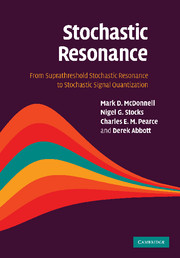Book contents
- Frontmatter
- Contents
- List of figures
- List of tables
- Preface
- Foreword
- Acknowledgments
- 1 Introduction and motivation
- 2 Stochastic resonance: its definition, history, and debates
- 3 Stochastic quantization
- 4 Suprathreshold stochastic resonance: encoding
- 5 Suprathreshold stochastic resonance: large N encoding
- 6 Suprathreshold stochastic resonance: decoding
- 7 Suprathreshold stochastic resonance: large N decoding
- 8 Optimal stochastic quantization
- 9 SSR, neural coding, and performance tradeoffs
- 10 Stochastic resonance in the auditory system
- 11 The future of stochastic resonance and suprathreshold stochastic resonance
- Appendix 1 Suprathreshold stochastic resonance
- Appendix 2 Large N suprathreshold stochastic resonance
- Appendix 3 Suprathreshold stochastic resonance decoding
- References
- List of abbreviations
- Index
- Biographies
1 - Introduction and motivation
Published online by Cambridge University Press: 23 October 2009
- Frontmatter
- Contents
- List of figures
- List of tables
- Preface
- Foreword
- Acknowledgments
- 1 Introduction and motivation
- 2 Stochastic resonance: its definition, history, and debates
- 3 Stochastic quantization
- 4 Suprathreshold stochastic resonance: encoding
- 5 Suprathreshold stochastic resonance: large N encoding
- 6 Suprathreshold stochastic resonance: decoding
- 7 Suprathreshold stochastic resonance: large N decoding
- 8 Optimal stochastic quantization
- 9 SSR, neural coding, and performance tradeoffs
- 10 Stochastic resonance in the auditory system
- 11 The future of stochastic resonance and suprathreshold stochastic resonance
- Appendix 1 Suprathreshold stochastic resonance
- Appendix 2 Large N suprathreshold stochastic resonance
- Appendix 3 Suprathreshold stochastic resonance decoding
- References
- List of abbreviations
- Index
- Biographies
Summary
Background and motivation
We begin by briefly outlining the background and motivation for this book, before giving an overview of each chapter, and pointing out the most significant questions addressed.
Although the methodology used is firmly within the fields of signal processing and mathematical physics, the motivation is interdisciplinary in nature.
The initial open questions that inspired this direction were:
(i) How might neurons make use of a phenomenon known as stochastic resonance?
(ii) How might a path towards engineering applications inspired by these studies be initiated?
Stochastic resonance and sensory neural coding
Stochastic resonance (SR) is a counter-intuitive phenomenon where the presence of noise in a nonlinear system is essential for optimal system performance. It is not a technique. Instead, it is an effect that might be observed and potentially exploited or induced. It has been observed to occur in many systems, including in both neurons and electronic circuits.
A motivating idea is that since we know the brain is far better at many tasks compared to electronic and computing devices, then maybe we can learn something from the brain. If we can ultimately better understand the possible exploitation of SR in the brain and nervous system, we may also be able to improve aspects of electronic systems.
Although it is important to have an overall vision, in practical terms it is necessary to consider a concrete starting point. This book is particularly focused on an exciting new development in the field of SR, known as suprathreshold stochastic resonance (SSR) (Stocks 2000c). Suprathreshold stochastic resonance occurs in a parallel array of simple threshold devices.
- Type
- Chapter
- Information
- Stochastic ResonanceFrom Suprathreshold Stochastic Resonance to Stochastic Signal Quantization, pp. 1 - 5Publisher: Cambridge University PressPrint publication year: 2008



